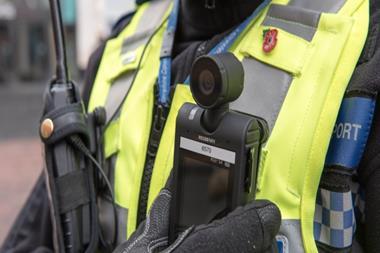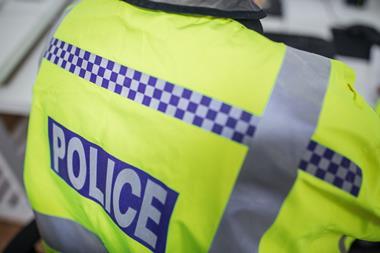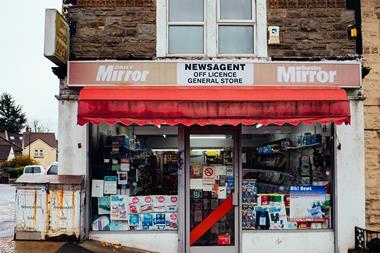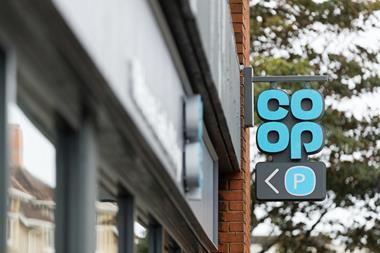One of the most startling figures in the BRC's 13th crime survey is that the value of losses from undetected customer theft rose by 44% in 2005 - from £400m to £578m - 28% of the total cost of crime.
But this is just the tip of the iceberg, according to the BRC's director general, Kevin Hawkins.
A lot of retail crime is going unreported, he says, because retailers don't think the police are interested in it and believe magistrates
will merely give offenders "a rap
on the knuckles".
Retailers are making an effort to combat crime but Hawkins believes the authorities are doing nowhere near enough to help them. "The overall investment by retailers in crime prevention has been £700m a year for the past six years," he says.
"That's a very big commitment, but it takes two to tango and we need investment from the criminal justice system to provide effective deterrents. Crime isn't like rain - it doesn't fall equally on everyone. It depends on your position - whether you're seen as vulnerable, whether you sell alcohol or cigarettes. For some retailers it isn't as big a problem as for others."
This is where the police come in. However, retailers can take additional measures, he adds. "The more you train your staff to be vigilant and make sure staff are always present on the shop floor, the more effective you can be.
"Retailers know they should be doing certain things to combat crime. The Home Office has issued guidance, we have issued guidance and at the end of the day it's down to retailers to protect themselves."
It's not like they are not trying to cut crime. Yet the number of shoplifting incidents has risen 70% since 2000 - even though the industry has invested more than £4.3bn in crime prevention in that period.
Couple this with the fact that the government's sentencing advisory panel has proposed that the courts avoid sending shoplifters to jail, and it is easy to see why retail groups such as the Association of Convenience Stores are becoming anxious and why three-quarters of retailers are dissatisfied with Whitehall's lack of success at reducing crime.
James Lowman, director of public affairs and soon-to-be chief executive of the ACS, says the panel's proposal does not bode well - for smaller retailers in particular.
"It sends the wrong message and implies shop theft is somehow victimless and not important," he says.
"Too often there's a lack of evidence, or police don't take it seriously and the retailer thinks there's no point in reporting a crime - but there's every point in reporting it and working with crime reduction partnerships to break the cycle.
"Retailers also need to think about their procedures. It's all very well for them to invest in equipment but they should be thinking about how they handle high-value products, open and close the store and handle cash. It can be just as important as a new CCTV system."
According to the BRC's figures,
c-stores were at the sharp end of the increase - of those retailers who experienced an increase in crime, 31% were in that category.
The good news is that many have recognised the problem and are taking action.
Manchester Costcutter owner Robert Madden was so fed up after being burgled seven times in a year that he took matters into his own hands and installed a new forensic trace alarm. If confronted by a criminal, staff press a panic button, and a red dye that takes several days of washing to get off is squirted on the offender.
The dye also has a ultra-violet element that contains a unique DNA to enable police to match criminals with crimes. The system costs £10 per week to lease.
In fact 73% of convenience stores have increased investment in crime prevention measures, including The Midcounties Co-operative's new store in Long Hanborough, Oxfordshire.
It has 24-hour CCTV, high gates and surrounding fences and a shop window that enables staff to see at all times who is entering the store and using the car park.
Other stores have introduced Mosquito, a device that emits a high-frequency noise to disperse gangs of youths.
It has since won a community safety award for its crime prevention measures.
The survey also revealed that detected staff crime was on the rise - from £17.8m to £23m. Undetected staff crime, however, fell from £480m to £320m.
"Retailers have got a lot better," says Noel Walsh, head of workplace safety at law firm Weightmans, which specialises in retail crime and violence.
"While spying on staff is frowned on, the fact is a lot of large supermarkets have discreet cameras that focus on tills and can match what's on video and what's later printed out on the system."
Walsh also believes retailers need to train staff better if they want to beat crime.
"For example, if there is a robbery, some staff aren't sure whether they should be hitting the panic button or handing over the cash. That needs to be addressed."
A spokeswoman for Sainsbury's agrees that larger retailers have more resources devoted to crime prevention.
"We have a range of surveillance, such as CCTV, and in-store security and tagging measures, civil recovery procedures and partnerships with local police," she says.
"There is a need for a greater level of co-operation among the retail community. We need to share information in order to deal with persistent offenders."Crime the statistics 2005
50%
The percentage of supermarkets that said retail crime had increased
40%
The percentage of convenience stores that experienced an increase
£318m
Total explained or detected crime losses were actually down 20% on 2004
£578m
However, undetected customer crime rose by
an estimated £178m
£343m
Total losses from staff theft fell dramatically from £498m in 2004
£738
The average value of goods stolen per incident was up, from £685
£17m
The losses incurred by burglaries were up from £16m in 2004
£4,028
The average cost per robbery was also up sharply from £2,694 in 2004
But this is just the tip of the iceberg, according to the BRC's director general, Kevin Hawkins.
A lot of retail crime is going unreported, he says, because retailers don't think the police are interested in it and believe magistrates
will merely give offenders "a rap
on the knuckles".
Retailers are making an effort to combat crime but Hawkins believes the authorities are doing nowhere near enough to help them. "The overall investment by retailers in crime prevention has been £700m a year for the past six years," he says.
"That's a very big commitment, but it takes two to tango and we need investment from the criminal justice system to provide effective deterrents. Crime isn't like rain - it doesn't fall equally on everyone. It depends on your position - whether you're seen as vulnerable, whether you sell alcohol or cigarettes. For some retailers it isn't as big a problem as for others."
This is where the police come in. However, retailers can take additional measures, he adds. "The more you train your staff to be vigilant and make sure staff are always present on the shop floor, the more effective you can be.
"Retailers know they should be doing certain things to combat crime. The Home Office has issued guidance, we have issued guidance and at the end of the day it's down to retailers to protect themselves."
It's not like they are not trying to cut crime. Yet the number of shoplifting incidents has risen 70% since 2000 - even though the industry has invested more than £4.3bn in crime prevention in that period.
Couple this with the fact that the government's sentencing advisory panel has proposed that the courts avoid sending shoplifters to jail, and it is easy to see why retail groups such as the Association of Convenience Stores are becoming anxious and why three-quarters of retailers are dissatisfied with Whitehall's lack of success at reducing crime.
James Lowman, director of public affairs and soon-to-be chief executive of the ACS, says the panel's proposal does not bode well - for smaller retailers in particular.
"It sends the wrong message and implies shop theft is somehow victimless and not important," he says.
"Too often there's a lack of evidence, or police don't take it seriously and the retailer thinks there's no point in reporting a crime - but there's every point in reporting it and working with crime reduction partnerships to break the cycle.
"Retailers also need to think about their procedures. It's all very well for them to invest in equipment but they should be thinking about how they handle high-value products, open and close the store and handle cash. It can be just as important as a new CCTV system."
According to the BRC's figures,
c-stores were at the sharp end of the increase - of those retailers who experienced an increase in crime, 31% were in that category.
The good news is that many have recognised the problem and are taking action.
Manchester Costcutter owner Robert Madden was so fed up after being burgled seven times in a year that he took matters into his own hands and installed a new forensic trace alarm. If confronted by a criminal, staff press a panic button, and a red dye that takes several days of washing to get off is squirted on the offender.
The dye also has a ultra-violet element that contains a unique DNA to enable police to match criminals with crimes. The system costs £10 per week to lease.
In fact 73% of convenience stores have increased investment in crime prevention measures, including The Midcounties Co-operative's new store in Long Hanborough, Oxfordshire.
It has 24-hour CCTV, high gates and surrounding fences and a shop window that enables staff to see at all times who is entering the store and using the car park.
Other stores have introduced Mosquito, a device that emits a high-frequency noise to disperse gangs of youths.
It has since won a community safety award for its crime prevention measures.
The survey also revealed that detected staff crime was on the rise - from £17.8m to £23m. Undetected staff crime, however, fell from £480m to £320m.
"Retailers have got a lot better," says Noel Walsh, head of workplace safety at law firm Weightmans, which specialises in retail crime and violence.
"While spying on staff is frowned on, the fact is a lot of large supermarkets have discreet cameras that focus on tills and can match what's on video and what's later printed out on the system."
Walsh also believes retailers need to train staff better if they want to beat crime.
"For example, if there is a robbery, some staff aren't sure whether they should be hitting the panic button or handing over the cash. That needs to be addressed."
A spokeswoman for Sainsbury's agrees that larger retailers have more resources devoted to crime prevention.
"We have a range of surveillance, such as CCTV, and in-store security and tagging measures, civil recovery procedures and partnerships with local police," she says.
"There is a need for a greater level of co-operation among the retail community. We need to share information in order to deal with persistent offenders."Crime the statistics 2005
50%
The percentage of supermarkets that said retail crime had increased
40%
The percentage of convenience stores that experienced an increase
£318m
Total explained or detected crime losses were actually down 20% on 2004
£578m
However, undetected customer crime rose by
an estimated £178m
£343m
Total losses from staff theft fell dramatically from £498m in 2004
£738
The average value of goods stolen per incident was up, from £685
£17m
The losses incurred by burglaries were up from £16m in 2004
£4,028
The average cost per robbery was also up sharply from £2,694 in 2004



















No comments yet